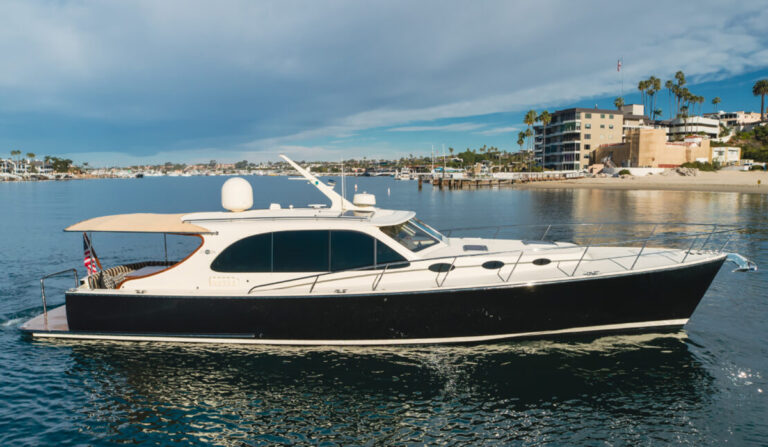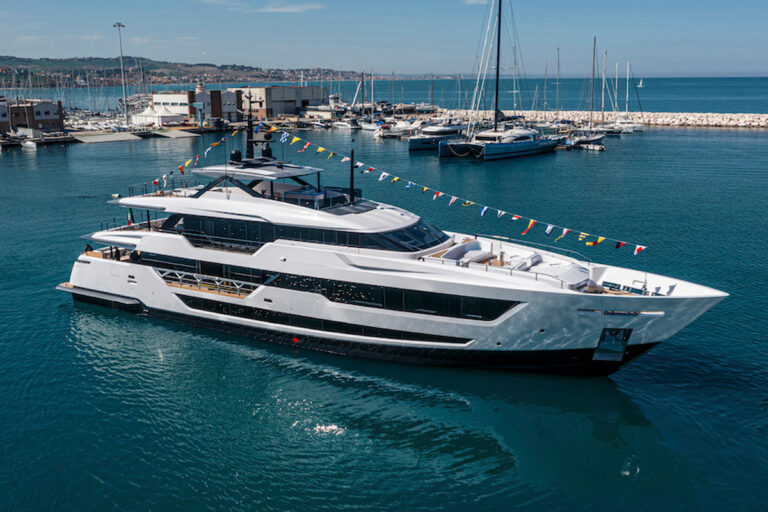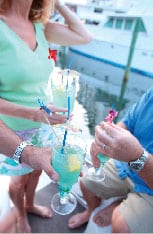
CY3
Barbecuing and boats are a natural combination, and, when seasoned with fresh air, sun and good friends, you’ve got all the makings for a great floating party. Yet, as with so many skills in boating, you need to learn the basics before, as the Aussies say, “you throw the shrimp on the barbie.”
I’m lucky when it comes to food because my wife, Rhea, is a gourmet chef who has owned French restaurants and a party catering service. Just as important, however, is that she has spent a lifetime around yachts, and I have to admit that we have had some legendary parties afloat. Even if you don’t know the difference between hot dogs and beef bourguignon, it’s easy to entertain guests with a barbecue on board.
The starting point, says Rhea, is not just to buy some steaks and invite friends aboard. This summer, think about a gathering as an event, and plan all the details from the food to the drinks to the decor. Even something as simple as a paper umbrella in the drinks can change a gathering from just another meal to a colorful party.
To showcase some of Rhea’s tips, we decided to organize a casual gathering, and we chose a new Cruisers 48 Cantius for several reasons. First, it has a barbecue in the cockpit, which allows the chef to mingle with the guests even when grilling. Second, there is comfortable cockpit seating for alfresco meals, plus an inside dinette for more protection, and, on a nice evening, the opening sunroof would bring in the stars. The 48 also has a counter running along the starboard side of the salon that earned Rhea’s approval, serving nicely as a staging area for appetizers and drinks.
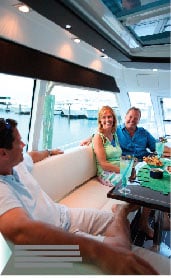
“One thing you have to remember,” says Rhea, “is that barbecuing isn’t like fast food. It’s about savoring the cooking process as an event that you share with friends. Plan your food so that each course can be enjoyed as the evening progresses. Watch the sunset, nibble on grilled appetizers, enjoy some special drinks.”
In this case, when our guests arrived, they were greeted with cheerful glasses of Blue Flamingos, a Rhea-devised drink similar to a daiquiri with blue curaçao for exotic taste and color, garnished with pineapple chunks on spinning pinwheel picks and tiny umbrella straws.
As our guests settled into the cockpit cushions, the first munchies appeared on the table, starting with assorted crackers and goat cheese topped with a chili pineapple salsa (see Rhea’s recipes here). Adding to the color was a fruit and cheese platter with a piña colada pear dip that kept guests occupied while I turned to the barbecue.
Our grilled appetizers were shrimp and scallops on skewers, which had been prepped beforehand in a lime-cilantro marinade (see the recipe, right). As these grilled, I also basted them with the remaining marinade. Tiny seafood icons on the skewer handles made a nice presentation at the table, accompanied by a mango curry chutney dipping sauce.
When it came time for the main course, we gave our guests the option of beef or fish. A flavorful ribeye steak was one choice, topped with Portobello mushrooms and accented by a stack of tomato and red onion slices drizzled in balsamic vinegar. Ribeyes are well marbleized, so they sear well and retain their juices, and Rhea had marinated the steaks in a mix of olive oil, red wine and McCormick Montreal Steak Seasoning a couple of hours before the guests arrived.
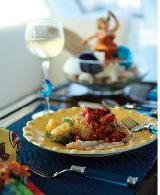
For the fish, the choice was tilapia, delicately flavored and yet firm enough not to fall apart on the grill like many fish fillets. To add drama to the fish, it was served over a cone of couscous Italiano mixed with chopped vegetables from the grill, and topped with the chili pineapple salsa.
Veggies are difficult to barbecue (they fall through the grate), so we used a vegetable tray to grill sliced bell peppers, onions and zucchini. Once off the grill, these were tossed with olive oil and Cavender’s Greek Seasoning. The thin-sliced Portobellos (sprinkled with Montreal Steak Seasoning) grilled right alongside the steaks and were turned frequently to prevent burning.
To add a final touch to our onboard barbecue soiree, Rhea created a grilled dessert that was quick and easy to prepare. A pineapple was cut into four-inch wedges beforehand, and a few moments on the barbecue added both flavor and grill marks. The pineapple wedges were topped with blackberries, strawberries, kiwi and a dollop of amaretto cream for a summery and light dessert.
Here are some tips for making your onboard barbecue a memorable evening.
Tools You’ll Need
• Tongs sturdy enough to lift a piece of meat are essential. Never use a fork to spear and turn the meat: It just punches holes that allow the juices to drain away.
• Use a wide spatula for turning fish.
• A grilling tray allows you to barbecue vegetables (which tend to fall through a grate) and delicate fish fillets (which tend to stick). Prep it with a light coating of olive oil.
• An instant-reading thermometer is valuable to provide your guests with steaks cooked to their preferences. With the sensor in the center of the meat, you can read the temperatures accurately: rare (120 to 125 degrees), medium rare (125 to 135), medium (135 to 145), medium well (145 to 155) and well (155 plus).
• You’ll need good skewers for kabobs as well as for shrimp and scallops. Double skewers keep the food from spinning when you turn them, and ours had miniature seafood sculptures that added to the decor.
• Your barbecue is also a tool, and you should take time to master it. Every grill has hot spots and cooler spots, which you can use to speed up or slow down the cooking for different foods.
• Without an oven-like thermometer on the grill to set the cooking temperature, you can turn to the classic “Mississippi” method. Hold your hand about three to four inches above the grill and do a “one-Mississippi, two-Mississippi” count. If you have to pull your hand away after two to three Mississippis, the heat is high; five to six Mississippis is medium, and nine to 11 is low heat.
Last, always preheat the grill and don’t rush the cooking. The food should sizzle when it hits the grill.
Decor
“Nothing turns just another meal into a festive occasion faster than a few simple decor tricks,” says Rhea. Brightly colored cocktail napkins for the glasses and appetizers are a no-brainer, and a tiny umbrella or a colorful pick with a pineapple spear adds to any drink concoction.
Create an atmosphere with cheerful cloth napkins in fun napkin rings (think parrots or shells), and finish the staging with place mats at each seating and under the appetizers. “You may be aboard a boat,” says Rhea, “but who wants to eat on paper plates with paper napkins?” Those are party no-no’s, especially when beautiful, eco-friendly, disposable bamboo dinnerware and unbreakable plates and glassware are available from Target to Pier 1.
Napkins, place mats and drink decorations stow easily in Ziploc baggies and take up little space until the next party.
Carnivorous Habits
Steak is a traditional favorite for onboard barbecues, but there are insider tips to know. Don’t grill a chilled steak straight from the fridge: Let it sit for 20 minutes or the interior won’t cook properly. Pat the steak dry before placing on the grill, especially if it’s been marinated, because wet meat won’t sear properly.
Searing the steak locks in the juices, so don’t flip the steak back and forth. With high heat, place the steak in a hot spot for about three minutes, and then turn it once. Don’t overcook the meat: You can always return it to the grill for a little more time. If you aren’t sure whether the meat is done, make a tiny slit with a knife on the “down” side of the meat and check the center. (Yes, expert barbecuers may scorn such a cut, but it’s better than under- or overcooked meat.)
Kabobs are a cinch to grill even for novices, but be sure to make the meat cubes the same size so they all cook at the same rate. If you have smaller pieces, put them on a separate skewer for less grilling time.
When it comes to burgers, buy ground chuck (18 percent fat) rather than ground round (12 percent), and you might even mix in a little ground sirloin to add more flavor. Make the patties about three-quarter-inch thick, and flip them just once using a spatula when the meat is firm enough to not stick to the grill.

Seafood
Barbecuing fish is more challenging than steak because the meat tends to be flaky and can stick to the grill. Don’t overmarinate fish because it can cause it to crumble. Wiping the grill with a pad saturated with olive oil can help the release, and high heat will crust the meat. For thin fillets, a grill basket will allow you to turn fish easily and safely.
Shrimp on the barbie is a tradition, and easy to do if you pay attention. Start with peeled and deveined large or extra-large shrimp to make them easy to handle. On the grill, they are done when they are firm to the touch, lightly charred and just turning opaque in the center.
Scallops are similar, and they are done when the exterior is lightly browned and the interior is opaque (cut one open to check).
Vegetables
A tray makes veggies easy to grill, but be sure to cut them into slices so the juicy surfaces caramelize from the heat. Wipe the tray with extra-virgin olive oil and stir occasionally to prevent sticking.
Don’t be shy about grilling fruit and vegetables that seem unlikely barbecue candidates. Artichokes, asparagus, apples, bananas, pineapple and corn on the cob are just a few that go well on the grill.
Summer’s here, and it’s time to start thinking about firing up the barbecue on the boat. Just remember to plan ahead to make your meal a memorable one, and don’t be shy about trying some new or untraditional dishes. Have fun!





